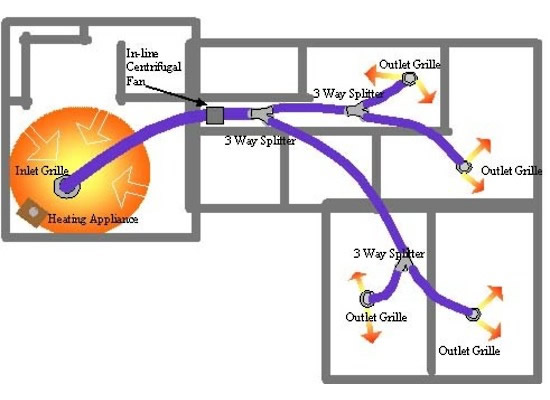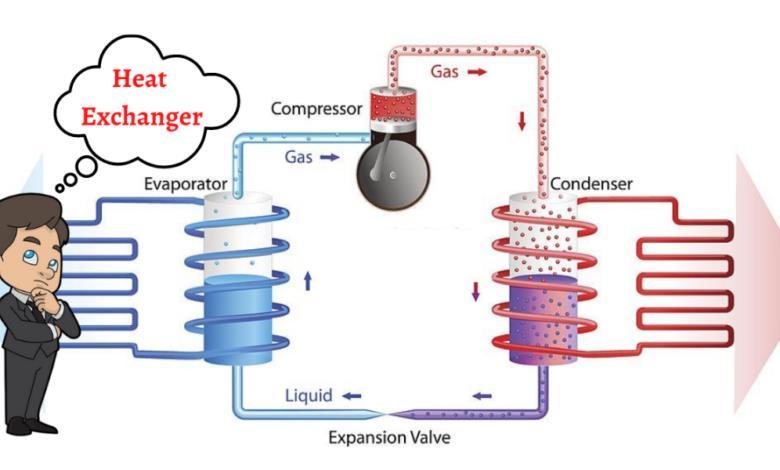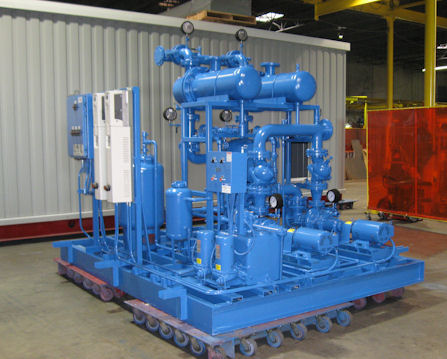Innovations in Heat Transfer Systems: What You Required to Know for Optimum Efficiency
Developments in Heat transfer systems are transforming efficiency across different sectors. Advanced materials like graphene and nanofluids assure considerable renovations in thermal conductivity. The combination of IoT and maker understanding offers possibilities for real-time tracking and boosted power effectiveness. However, the landscape of thermal management is quickly developing (DVS Heat Transfer Systems). Understanding these growths is important for accomplishing suitable system efficiency and sustainability in the future. What particular developments are shaping this transformation?
Emerging Materials for Enhanced Heat Transfer

Advanced Heat Exchanger Styles
While conventional Heat exchangers have served their objective in different applications, progressed styles are now emerging to fulfill the increasing demands for effectiveness and performance. These cutting-edge designs, such as plate, shell-and-tube, and finned-tube Heat exchangers, integrate boosted surface and enhanced circulation patterns to enhance thermal transfer rates. Furthermore, compact designs enable lowered room requirements without endangering efficiency. Advanced products, such as compounds and corrosion-resistant alloys, additionally enhance toughness and performance under extreme problems. Moreover, simulation technologies and computational liquid characteristics are increasingly utilized to improve these designs, ensuring peak Heat transfer attributes. As industries seek to minimize power usage and make the most of output, the fostering of advanced Heat exchanger designs is pivotal in achieving these purposes.
The Function of Nanotechnology in Heat Transfer
Nanotechnology plays a vital function in boosting thermal conductivity within Heat transfer systems. By controling products at the nanoscale, researchers have actually attained considerable improvements in power efficiency. These improvements not just enhance performance yet likewise add to even more sustainable energy services.
Boosted Thermal Conductivity
Substantial improvements in thermal conductivity have arised through the application of nanotechnology, transforming Heat transfer systems throughout numerous markets. By including nanoparticles right into Heat transfer fluids and materials, scientists have achieved impressive rises in thermal conductivity. These nanoparticles, such as carbon nanotubes, graphene, and steel oxides, boost the Heat transfer properties due to their high surface location and special thermal attributes. The resulting compounds display enhanced performance in applications varying from electronic devices cooling down systems to renewable energy technologies. Additionally, the capability to tailor the size, form, and structure of nanoparticles enables maximized thermal management services. Because of this, nanotechnology remains to play a pivotal function in the advancement of more reliable and reliable Heat transfer systems, leading the means for improved industrial applications.
Power Efficiency Improvements

Integration of IoT in Heat Transfer Equipments
The combination of IoT in Heat transfer systems introduces the execution of smart sensors that enhance operational effectiveness. These sensors enable real-time information tracking, permitting prompt modifications and optimizations. This technological advancement has the prospective to significantly boost performance and power administration in Heat transfer applications.
Smart Sensors Implementation
As Heat transfer systems progress, the combination of clever sensing units through the Net of Points (IoT) has actually arised as a transformative method. These sensing units enable real-time tracking of pressure, temperature, and circulation prices, improving system performance and integrity. By collecting and sending information, they promote positive upkeep, minimizing the risk of system failures. Furthermore, smart sensors add to power financial savings by refining functional specifications based upon ecological conditions. Their capability to analyze anomalies and fads permits informed decision-making, guaranteeing peak efficiency of Heat transfer systems. As sectors significantly embrace this modern technology, the implementation of smart sensors stands to transform exactly how Heat transfer systems are taken care of, paving the method for higher sustainability and improved efficiency end results.
Real-Time Data Surveillance
Exactly how can real-time information keeping track of boost the efficiency of Heat transfer systems? By incorporating Web of Points (IoT) technology, Heat transfer systems can leverage constant data collection from smart sensing units. This real-time tracking permits immediate evaluation of temperature, circulation, and pressure prices, making it possible for operators to recognize inadequacies promptly. Adjustments can be made to maximize efficiency, reduce power usage, and extend tools life expectancy. Additionally, anticipating maintenance can be applied, decreasing unanticipated downtime and pricey repair work. The capacity to visualize efficiency metrics via dashboards improves decision-making, fostering an aggressive method to system management. Ultimately, real-time information keeping track of not just enhances functional effectiveness yet likewise contributes to sustainability goals within commercial processes.
Energy Performance and Sustainability Trends
Energy performance and sustainability fads are reshaping the landscape of Heat transfer systems, driving innovation and conformity throughout numerous industries. Organizations are progressively prioritizing energy-efficient layouts to reduce functional prices and lessen ecological influences. The combination of renewable resource sources is becoming extra common, enabling Heat transfer systems to operate sustainably while fulfilling governing needs. Furthermore, improvements in technologies and products promote lower energy consumption and boost overall performance. Lifecycle assessments are also acquiring grip, allowing business to assess the ecological impact of Heat transfer systems from manufacturing to disposal. This concentrate on sustainability not only supports corporate duty yet also positions organizations competitively in a market where customers progressively favor green solutions. Power efficiency and sustainability stay critical factors to consider for future growths in Heat transfer technology.
Innovations in Thermal Administration Solutions
While the need for efficient Heat transfer proceeds to rise, advancements in thermal administration solutions are emerging to deal with both efficiency and sustainability challenges. Advanced products, such as phase adjustment materials and nanofluids, are being established to boost Heat transfer efficiency - DVS Heat Transfer Systems. These products boost thermal conductivity and enable much better his explanation temperature level guideline in different applications. Furthermore, innovations like energetic thermal control systems are acquiring grip, allowing real-time adjustments to manage Heat flow effectively. These systems add to energy financial savings and lower the environmental effect of thermal procedures. The combination of IoT in thermal administration facilitates tracking and anticipating maintenance, ensuring optimized performance and long life of Heat transfer systems. On the whole, these developments represent considerable strides towards more lasting thermal administration practices
Future Instructions in Heat Transfer Technology
Arising innovations in thermal monitoring remedies signal an appealing future for Heat transfer technology. Scientists are progressively concentrating on establishing products with superior thermal conductivity and boosted energy effectiveness. Developments such as nanofluids, which contain suspended nanoparticles, provide considerable renovations in Heat transfer performance. Additionally, the combination of wise materials that adapt to differing temperature level problems is obtaining traction, enabling for more receptive and efficient systems. The increase of additive production methods is also making it possible for the design of complex Heat exchanger geometries that enhance fluid circulation. Moreover, the application of maker discovering algorithms is prepared for to transform the optimization of Heat transfer systems, helping with predictive maintenance and efficiency improvement. Jointly, these developments are positioned to change the landscape of Heat transfer innovations in numerous sectors.

Frequently Asked Inquiries

Just how Do I Select the Right Heat Transfer System for My Application?
Selecting the best Heat transfer system involves examining application demands, consisting of temperature level varieties, fluid properties, and performance demands. Evaluating system kinds, maintenance considerations, and cost-effectiveness additionally plays an important function in making an educated choice.
What Are the Upkeep Needs for Advanced Heat Exchangers?
Maintenance demands for sophisticated Heat exchangers commonly consist of normal inspections, keeping track of for leaks, cleaning of surfaces, and assuring perfect flow prices. Abiding by maker guidelines guarantees reliable procedure and lengthens the devices's life-span.
Just How Do Environmental Variables Impact Heat Transfer Effectiveness?
Ecological variables substantially influence Heat transfer effectiveness. Variants in humidity, air movement, and temperature level impact thermal conductivity and convective Heat transfer, inevitably influencing system performance and demanding consideration throughout the style and procedure of Heat transfer systems.
What Security Specifications Put On Heat Transfer Solutions?
Safety and security requirements for Heat transfer systems generally consist of standards from companies such as ASME and ASTM. DVS Heat Transfer Systems. These standards address products, style, and operational methods to guarantee integrity, performance, and protection versus risks in various applications
How Can I Repair Common Heat Transfer System Issues?
Repairing usual Heat transfer system concerns involves looking for leakages, ensuring appropriate liquid circulation, evaluating insulation integrity, and confirming temperature differentials. Determining these variables can help keep system efficiency and stop further problems.
Nanotechnology plays an essential duty in enhancing thermal conductivity within Heat transfer systems. Substantial innovations in thermal conductivity have arised via the application of nanotechnology, revolutionizing Heat transfer systems throughout different sectors. Improvements in thermal conductivity through nanotechnology Resources have led the method for exceptional enhancements in power performance within Heat transfer systems. Power efficiency and sustainability patterns are reshaping the landscape of Heat transfer systems, driving technology and useful source conformity throughout various markets. The integration of IoT in thermal monitoring facilitates tracking and predictive upkeep, making certain enhanced performance and long life of Heat transfer systems.